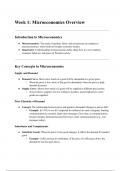Week 1: Microeconomics Overview
Introduction to Microeconomics
● Microeconomics: The study of markets, firms, and transactions (in contrast to
macroeconomics, which looks at broader economic trends).
● Importance: Understanding microeconomics helps shape how we view markets,
consumer behavior, and prices in Western society.
Key Concepts in Microeconomics
Supply and Demand
● Demand Curve: Shows how much of a good will be demanded at a given price.
○ When the price is low, more of the good is demanded; when the price is high,
demand decreases.
● Supply Curve: Shows how much of a good will be supplied at different price points.
○ At low prices, suppliers are less willing to produce, and at high prices, more
goods are supplied.
Price Elasticity of Demand
● Concept: The relationship between price and quantity demanded changes as prices shift.
○ Example: In 1870, it cost $15 (adjusted for inflation) to send a telegram, limiting
communication to essential, high-value messages. Over time, as communication
became cheaper, demand increased for lower-value communications (e.g., text
messages today).
Substitutes and Complements
● Substitute Goods: When the price of one good changes, it affects the demand for another
good.
○ Example: Coffee and tea are substitutes. If the price of coffee goes down, the
demand for tea also goes down.
, ● Complementary Goods: When the price of one good changes, the demand for its
complement shifts.
○ Example: If the price of coffee decreases, the demand for sugar (a complement to
coffee) may increase.
Economic Examples and Case Studies
Telecommunications Example
● Historical Context: In the 1960s, a three-minute long-distance phone call cost the
inflation-adjusted equivalent of $12. Today, with cell phones and the internet, most
people have unlimited calls for a flat rate.
○ The decrease in communication costs increased the volume of messages (from 9
million telegrams per year in 1870 to 2 trillion text messages annually in the U.S.
today).
Oil Market Dynamics
● Political Strategy: During the pandemic in 2020, Saudi Arabia and Russia intentionally
drove oil prices down to reduce competition from North American fracking, anticipating
future profits when supply rebounded.
Electric Cars and Charging Stations
● UCLA Example: Free electric car charging increases demand among those who can't
charge at home. If workplace charging prices increased, fewer people would use it,
especially those with home charging alternatives.
Technology and Labor Substitution
Technological Substitution
● Concept: As technology improves, companies substitute labor with machines to reduce
costs.
○ Example: McDonald's uses self-checkout kiosks (iPads) instead of hiring
cashiers, passing the labor cost savings to consumers through potentially lower
prices.
, Supply Curve Shifts
● Fracking Technology: Technological advances, such as fracking, can shift the supply
curve by lowering production costs.
○ Example: Fracking made it economically feasible to extract fossil fuels in North
Dakota, increasing the supply of natural gas at any given price.
Elasticity of Demand
Gasoline Demand Elasticity
● Short-Run Inelasticity: Gasoline demand is inelastic in the short run because people
need to drive, even if prices rise.
● Long-Run Elasticity: Over time, as consumers switch to alternatives like electric cars,
gasoline demand becomes more elastic.
Housing and Gasoline Example
● Early 2000s: People bought homes far from city centers, assuming gasoline would
remain cheap. When prices rose in 2007, demand for suburban housing fell due to high
commuting costs.
Market Concepts and Behavior
Diamond-Water Paradox
● Paradox: Water, essential for life, is cheap because it is abundant, while diamonds,
which have little practical use, are expensive due to their rarity.
○ Lesson: Prices depend on scarcity, not just utility.
Law of One Price
● Concept: Ideally, all consumers should pay similar prices for the same goods in a given
market.
○ Example: Gasoline prices vary slightly between stations, but consumers with
price comparison apps pay roughly the same amount.




